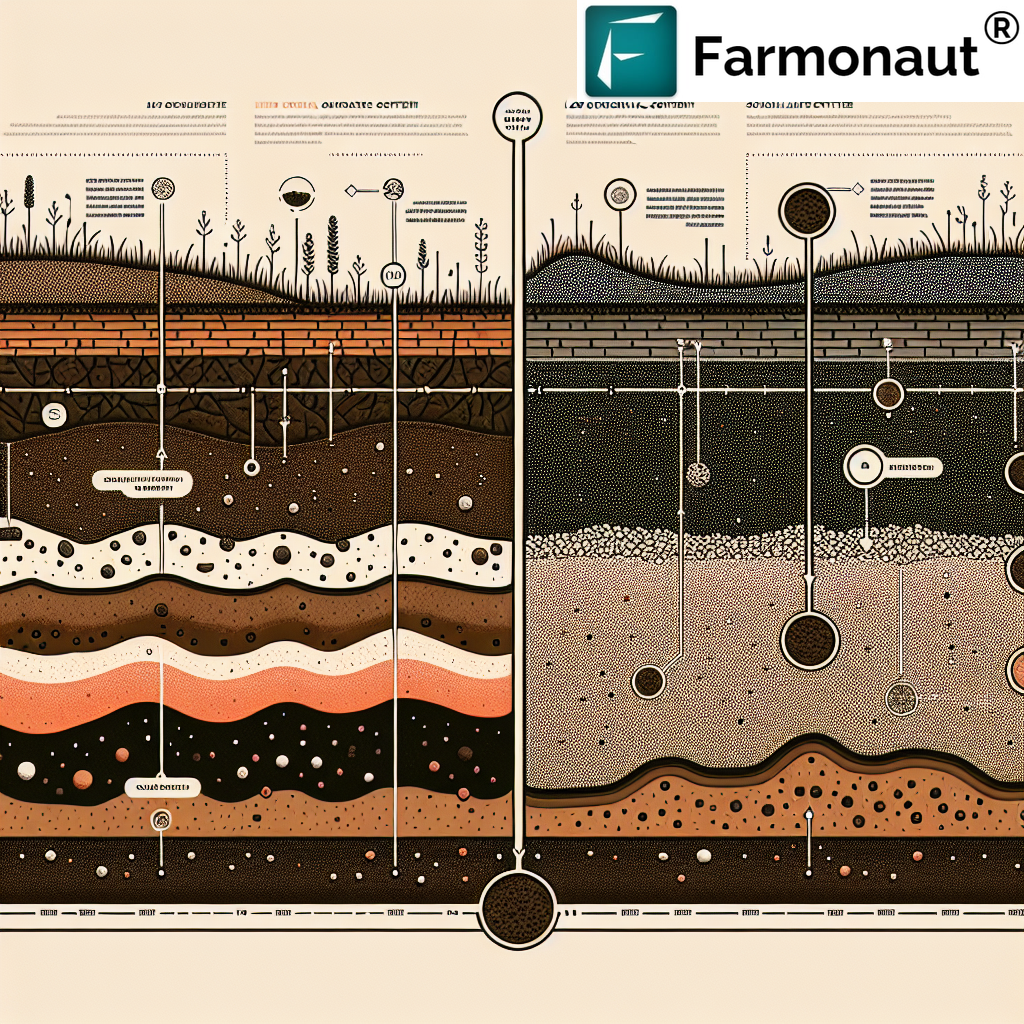Bronzing in Guava Due to Deficiency: 5 Proven 2025 Solutions
Meta summary:
Understanding nutrient deficiencies in fruit crops is crucial for sustainable progress in 2025. This article explains the causes of bronzing in guava due to deficiency of calcium, magnesium, and phosphorus, the role of these nutrients in crops like guava and cucumbers, and delivers actionable 2025 solutions driven by the most advanced precision agriculture and remote sensing technology.
Table of Contents
- Why Deficiency Hits Fruit Crops: Causes and Impact
- Bronzing in Guava Due to Deficiency of Calcium, Magnesium, and Phosphorus
- Cal-Mag Deficiency in Flower and Flowering Challenges
- Phosphorus Deficiency: The Hidden Growth Limiter
- Calcium Deficiency in Cucumbers: Brown, Tip Burn Issues
- Understanding Precision Nutrient Management in 2025
- Farmonaut AI & Satellite Remote Sensing for Nutrient Deficiency Management
- Deficiency Symptoms and Precision Solutions Table
- 5 Proven 2025 Solutions to Manage Bronzing in Guava Due to Deficiency
- Farmonaut Apps & API for Satellite Remote Diagnostics
- FAQ: Bronzing in Guava and Precision Nutrient Management
- Conclusion
Why Deficiency Hits Fruit Crops: Causes and Impact
Inefficient management of nutrient levels in the soil and an inability to quickly identify deficiency symptoms are among the main challenges facing fruit crop growers worldwide. As the tropical psidium guajava (guava) and cucumbers become increasingly important in the global market, bronzing in guava due to deficiency and brown spots on guava fruit caused by cal-mag or phosphorus deficiencies significantly reduce crop quality, yield, and grower income.
- Intensive cropping & monoculture deplete crucial nutrients faster, worsening deficiencies.
- Poor soil testing or outdated fertilization results in unseen imbalances, often making symptoms visible only when damage is done.
- Environmental shifts – like erratic rainfall, high humidity, or drought – disrupt the transpiration stream and limit calcium or magnesium transfer to young, developing fruits and leaves.
Fruit Nutrient Deficiency in 2025: The Economic Stakes
By 2025, the impact of deficiencies reaches beyond yield losses; it affects market value (due to poor visual quality and shelf life), invites pathogen attacks, and can ultimately destabilize smallholder livelihoods in many countries. The solution? Precision management powered by science and satellite technology.
Focus keyword: bronzing in guava due to deficiency of
Short Meta note: This article delves into the manifestations, signs and solutions for calcium, magnesium and phosphorus deficiencies in guava and cucumbers, with advanced, tech-driven strategies for 2025.
Bronzing in Guava Due to Deficiency of Calcium, Magnesium, and Phosphorus
Among psidium guajava fruit growers, bronzing in guava due to deficiency of magnesium or calcium presents as a key marker of underlying soil nutrient imbalance.
- Guava bronzing symptoms:
– Magnesium deficiency: Typically starts as chlorosis (yellowing) in older leaves, evolving into a bronzed appearance as chlorophyll content decreases.
– Calcium deficiency: Presents alongside brown spots on guava fruit, especially near the blossom end or as randomly scattered necrotic spots associated with cell wall failure. -
Why is this a problem?
- Impaired photosynthesis, energy transfer, reduced growth, and decreased fruit yield.
- Lowered nutritional, aesthetic, and market value.
- Increased secondary infections as weak cell walls allow pathogen entry.
Diagnosing these deficiencies early is critical. Guava is highly responsive to magnesium, calcium, and phosphorus, so any imbalance will manifest as clear symptoms – leaf bronzing, brown spots on the skin, and in severe cases, cell collapse with sunken or rough patches.
Cal-Mag Deficiency in Flower and Flowering Challenges
Cal-mag deficiency in flower development can trigger a cascade of failures in guava, cucumbers, and other fruit crops:
- Poor flower set: Cells in new flower buds require stable calcium for membrane integrity. Weak cell walls cause disintegration and bud drop.
- Magnesium’s role: As a central component of the chlorophyll molecule, magnesium is essential for energy transfer and all aspects of photosynthesis. Deficiency means less energy for growth, impaired pollen viability, and malformed fruits.
- Results: Greater economic losses, wasted inputs, and reduced market value in 2025.
Phosphorus Deficiency: The Hidden Growth Limiter
Often considered the “silent yield limiter”, phosphorus deficiency holds back early growth, delays flowering, and restricts root development in both guava and cucumbers.
-
Symptoms in guava and cucumbers:
– Guava: Shorter roots, delayed fruit set, stunted fruit, dark green to purplish leaves.
– Cucumbers: Stunted initial growth, poor flower emergence, decreased fruit yield. -
Why does phosphorus matter?
It is essential in energy transfer (as ATP), nucleic acid synthesis, and powering the metabolic reactions that drive optimal development in high-value fruit crops like guava and cucumber.
Calcium Deficiency in Cucumbers: Brown, Tip Burn Issues
Attention to calcium deficiency in cucumbers is vital since calcium has low mobility within the plant. Fruits and fast-growing tissues (such as developing cucumber tips) can quickly show symptoms of necrotic, brown patches or “tip burn” if deficiency occurs.
- Fruit ends (blossom-end or tip) become brown, water-soaked, and necrotic, sometimes with sunken patches.
- Impact: Short shelf-life, poor quality, yield loss, allows pathogen invasion, and market rejection.
- If the transpiration stream is blocked (by high humidity, water stress, or excessive nitrogen), calcium cannot reach the actively growing fruit, leading to these visible deficiencies.
In both guava and cucumbers, a proactive approach in nutrient management backed by rapid diagnostics, remote sensing, and routine testing is the gateway to sustainable crop health and productivity in 2025.
Understanding Precision Nutrient Management in 2025
The core of nutrient management in 2025 relies on early understanding and technological innovation. For growers to overcome challenges around deficiencies leading to bronzing in guava, necrosis, brown spots in cucumber, and losses in fruit yield, the following approaches set the standard:
- Real-time monitoring and early warning: Remotely identify visible symptoms using AI, satellite imagery, and field scouts.
- GIS-based soil testing and maps: Pinpoint deficiency “hotspots” for optimal input.
- Sensor integration: Combine leaf tissue and soil test results with remote visual data for balanced fertilization and to reduce losses.
- Smart recommendations: Automated, data-driven dosages and schedules for fertilizer and water.
- Blockchain traceability: Prove and trace the reduced use of chemical fertilizers for enhanced marketability using blockchain-based product traceability from Farmonaut.
The next section details how Farmonaut’s satellite and AI tools empower the fruit industry for these exact 2025 needs.
Farmonaut AI & Satellite Remote Sensing for Nutrient Deficiency Management
In a world moving towards full digital transformation, we at Farmonaut stand at the intersection of AI advisory systems, satellite imagery, and blockchain-driven traceability specifically tailored to agriculture and fruit crops management. Our affordable platform ensures that farmers, businesses, and governments have direct access to advanced real-time monitoring, remote nutrient diagnostics, and environmental impact metrics at the right time.
- Satellite-based Crop Monitoring detects early signs of deficiency (such as bronzing in guava) via NDVI, CCI, and more.
- Jeevn AI Advisory System generates tailored alerts and actionable fertilization guidance using real-time satellite tissue health metrics.
- Blockchain-based Traceability empowers growers to prove reduced dependence on chemical fertilizers – visit Farmonaut Traceability Solution for more details.
- APIs (Explore API Developer Docs) allow agricultural businesses to integrate our satellite analytics for large-scale, automated nutrient deficiency surveillance and intervention.
- Accessible via App or Web: Crop management, deficiency mapping, and recommendations-anywhere, anytime. Large-Scale Farm Management Features let supervisors monitor multiple blocks of guava or cucumber in real-time.
For resource optimization and risk management in guava orchards, our suite of satellite-enabled advisory tools can dramatically enhance both the quality and productivity of fruit, while reducing raw input and operational losses.
Deficiency Symptoms and Precision Solutions Table — 2025 Focus
Below is a comprehensive table designed for mobile responsiveness, comparing key nutrient deficiencies in guava and cucumbers, their visible symptoms, estimated yield loss anticipated in 2025, corresponding Farmonaut remote sensing indicators, and recommended precision management solutions for each.
| Nutrient | Deficiency Symptoms in Guava & Cucumbers | Estimated Yield Loss (2025) | Farmonaut Remote Sensory Indicators | 2025 Precision Management Solution |
|---|---|---|---|---|
| Calcium (Ca) |
|
15–35% |
|
|
| Magnesium (Mg) |
|
10–25% |
|
|
| Phosphorus (P) |
|
8–18% |
|
|
5 Proven 2025 Solutions to Manage Bronzing in Guava Due to Deficiency
The 2025 approach to tackling bronzing in guava due to deficiency of calcium, magnesium, and phosphorus emphasizes precision, early diagnosis, sustainability, and yield optimization. Here’s how to solve the most common and severe deficiencies:
1. Soil and Leaf Tissue Testing
- Conduct frequent soil and leaf tissue tests every season to detect imbalances in calcium, magnesium, and phosphorus.
- Focus: Map spatial variability, not just average levels, for micro/macro-plot targeting.
- Analysis helps guide which blocks or fields get immediate corrective action, preventing widespread losses.
Farmonaut’s satellite monitoring platform shows block-wise NDVI/CCI anomalies, allowing agronomists to prioritize areas for field testing and early correction.
2. Balanced Fertilization for Optimal Nutrient Supply
- Apply calcium nitrate for calcium, Epsom salts (magnesium sulfate) for magnesium, and superphosphates based on test results — but with a focus on balanced fertilization to avoid new imbalances.
- Foliar sprays enable rapid correction, while soil amendments offer long-term improvement.
- Precision dosing using tech-assisted recommendations minimizes runoff and improves environmental sustainability.
Explore carbon footprint monitoring tools from Farmonaut for a dual approach to sustainable fertilization and global climate compliance.
3. Smart Irrigation & Integrated Water Management
- Calcium moves with the transpiration stream; thus, inconsistent watering leads to deficiency symptoms in guava and cucumbers despite proper fertilization.
- Adopt drip irrigation, automatic scheduling (AI/IoT), and soil moisture sensors for optimal Ca uptake and distribution.
- Prevents tip burn, blossom-end rot, and sudden necrotic patches.
Farmonaut’s fleet and resource management tools can help agribusinesses organize mobile teams and equipment for irrigation, reducing inefficient fieldwork and supporting water-and-nutrient management.
4. Use of Biofortified and Responsive Varieties
- Choose modern fruit varieties with higher efficiency for calcium, magnesium, and phosphorus uptake (consult agricultural extension data for your region).
- Incorporate varieties bred to resist bronzing and brown spots in guava and cucumber.
- Precision planting (with geolocated block mapping) maximizes new cultivar performance and limits losses in old fields.
For professional advisory on new plant or forest plantation schemes—including nutrient management compliance—access Farmonaut’s crop plantation and forest advisory services.
5. Precision Agriculture & Smart Satellite Management
- Deploy remote satellite monitoring for early warning of deficiencies in large guava or cucumber blocks.
- Combine AI-driven advisory with drone imaging for precise, field-level application of calcium/magnesium/phosphorus.
- Leverage blockchain-based traceability for value chain transparency and market premiums.
Need seamless integration with your enterprise systems? Discover the extensive Farmonaut Satellite & Weather API—ideal for remote diagnosis, monitoring, and reporting of fruit nutrient deficiencies in real time.
Farmonaut Apps & API for Satellite Remote Diagnostics
- Individual farmers can use Farmonaut’s web, Android, or iOS apps for NDVI/CCI visual maps and actionable alerts on bronzing in guava or tip burn in cucumbers.
- Large businesses and governments benefit from our Large Scale Farm Management suite for multi-field/region supervision, remote deficiency mapping, and live operational dashboards.
- Insurance & finance providers get satellite-based verification for crop health and deficiency risk, described further at Farmonaut’s crop loan and insurance technology.
- Supply chain leaders can boost market value by proving reduced agrochemical use through Farmonaut’s blockchain product traceability — vital for certifying quality from farm to consumer in 2025.
FAQ: Bronzing in Guava and Precision Nutrient Management
What causes bronzing in guava fruit, and why is it a problem in 2025?
Bronzing in guava due to deficiency of magnesium or calcium arises when essential nutrients drop below optimal levels in soil or are unable to reach developing fruits. This leads to reduced chlorophyll (magnesium) or weak cell wall structure (calcium), resulting in visible discoloration, compromised photosynthesis, poor fruit quality, and marketable losses. In 2025, increased sensitivity of global markets and sustainability requirements make it more vital than ever to correct these issues early.
How can precision agriculture and satellite technology help manage fruit nutrient deficiencies?
Precision agriculture—using tools like Farmonaut’s satellite crop health monitoring and AI-based advisory—offers early detection of nutrient deficiency symptoms across vast areas. This enables data-driven applications of fertilizers only where needed, reduces input waste, and prevents widespread yield or quality loss. Satellite imagery also allows agronomists and business managers to verify improvement and optimize input scheduling, even for remote or large-scale farms.
What are the most common visual symptoms of calcium and magnesium deficiencies in guava and cucumbers?
In guava, calcium deficiency appears as brown, sunken spots on fruit and flower drop; magnesium deficiency reveals as bronzing and yellowing (chlorosis) of older leaves, often worsening toward the tip and edges. In cucumbers, calcium deficiency shows as tip burn or blossom end rot, while magnesium deficiency manifests as interveinal leaf yellowing, reducing overall plant vigor.
Which Farmonaut features are most useful for monitoring bronzing and brown spots in fruit crops?
Farmonaut’s remote NDVI and chlorophyll content mapping, live anomaly alerts on leaf/fruit discoloration, AI-driven fertilization advisories, and blockchain traceability for certified lower input use are all invaluable. The platform is accessible via app or web for individual growers and supports APIs for agribusinesses managing large or distributed farms.
Are magnesium and phosphorus deficiencies always visible before yield drops?
No, magnesium and phosphorus deficiencies may not appear until yield is already affected. Early detection via routine soil and leaf tissue testing and remote sensing is crucial. Tech-driven monitoring like that offered by Farmonaut enables identification of hidden stress before symptoms appear, ensuring timely intervention.
Conclusion
The year 2025 marks a turning point in how we approach bronzing in guava due to deficiency of calcium, magnesium, and phosphorus in fruit agriculture. Precise understanding of nutrient deficiencies, their symptoms, the role of essential elements, and the resulting impact on yield and market value is now paired with actionable, satellite-enabled, and AI-driven management. Using Farmonaut’s affordable satellite platforms and robust advisory systems, growers, agronomists, businesses, and governments can proactively diagnose early deficiencies, optimize balanced fertilization, and track crop wellness in real time.
The future of tropical guava, cucumbers, and fruit crops will increasingly rely on such precision management for sustainable, profitable, and market-compliant production. For growers seeking to reduce bronzing, brown spots, or yield loss, the roadmap is clear: integrate the best of soil and tissue testing, balanced nutrient programs, water-smart practices, responsive cultivars, and, most critically, digital and satellite decision-making tools like Farmonaut. This holistic approach will protect quality, secure economic value, and guarantee productivity for 2025 and beyond.
Ready to bring your farm or agribusiness into the future of nutrient management?
Start now via web, Android or iOS:
For integration into your agri-enterprise system, visit our API portal and API developer documentation.
Bronzing and brown spots are no longer an unpredictable fate for guava and cucumber growers – in 2025, remote sensing, AI, and data are the new keys to sustainable crop nutrition, health, and prosperity.













